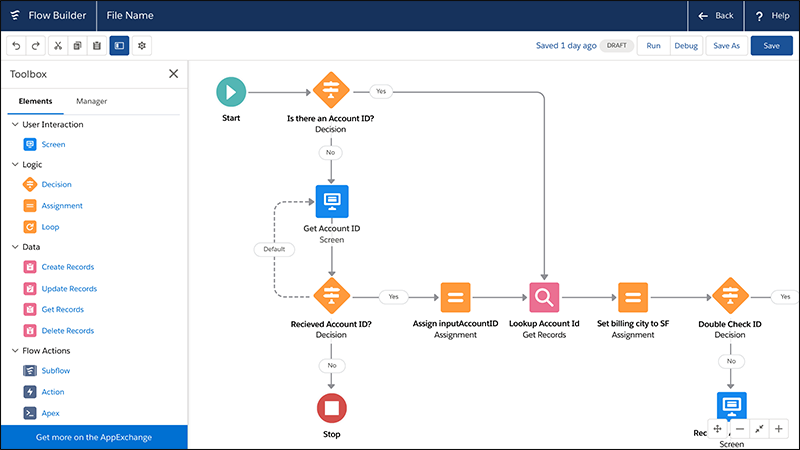Free Ideas For Choosing Low-Code Platform Sites
Free Ideas For Choosing Low-Code Platform Sites
Blog Article
Benefits Of Low-Code Application Development In Terms Of Accessibility To Non-Developers
The following main factors make low-code programming accessible to those who are not developers.
Drag-anddrop Builders: Lowcode platforms provide drag-and-drop interfaces, which let non-developers create visual applications, without needing codes. This makes development easier for those with no technical backgrounds.
WYSIWYG editors Editors that use WYSIWYG: These "What You See Is What You get" editors let users create workflows and interfaces that are like the finished version. This makes it much easier to understand and use.
Simple logic and Workflow Design
Visual Workflow modeling: Users can design business flows and application logic with visual flowcharts. These models are easier to use than traditional code methods.
Low-code platforms are often equipped with pre-built logic elements (e.g. the conditional loops, statements) that eliminate the need for complicated coding.
Reusable Components and Templates
Template libraries that are pre-built: A lot of low-code platforms offer an application library that can be used for the most common types of applications, allowing non-developers to have a foundation to build upon and then customize.
Reusable widgets and modules The process of creating web pages is made simpler by using reusable components as well as modules. This reduces the necessity for a deep technical understanding.
Guided Development and Tutorials
Step-by-Step Guides: Platforms typically provide a development path with guidance, online tutorials, or on-screen directions to help users who aren't developers to create applications.
Interactive Tutorials Interactive, hands-on tutorials help users learn by doing, enhancing their understanding and confidence in using the platform.
Integration with existing tools
Seamless Integration: Low-code platforms are designed to seamlessly integrate with the existing systems and tools in business (e.g. the CRM or ERP) This lets non-developers to develop applications that can work within existing workflows.
APIs/Connectors: The built-in APIs/connectors allow non-developers to connect their apps to external services.
Collaboration Features:
Team Collaboration Features, like real time collaboration and shared workspaces, enable non-developers and professionals to collaborate effectively.
Role Based Access Control: You can assign non-developers specific roles that correspond to the appropriate access level, so that they are able to participate in the development process without hindering security or the functionality.
Automated Testing & Debugging
Low-code platforms include tools for testing and debugging that are built-in. They automatize this procedure, making it much easier for nondevelopers to make sure their apps work.
Error-highlighting: The platform provides information on issues and suggestions to guide non-developers.
The ability of low-code applications to allow development for non-developers is its biggest advantage. With its an intuitive, visually-guided tool and experiences, low code platforms enable business owners to actively take part in and manage applications. View the most popular a knockout post for Low-code Platform for application development for site advice including push notifications android, azure sql server, rapid applications, multiplatform mobile app development, ms azure sql, software for app development, paas service, mobile development platforms, rapid action development, application modernization software and more.
Low-Code Apps Have Numerous Advantages In The Area Of Cost-Effectiveness.
Low-code development has many benefits in terms of cost-effectiveness. This is a great option for businesses that want to maximize their development budgets, but still delivering high quality applications. These are the main benefits: Reduced development costs:
A lower code platform reduces the need for long manual code. This means less time and effort of developers when developing applications. This means lower costs for labor.
Less developers: Since low-code development is quicker and easier and less complex, there are fewer developers needed. This will drastically lower costs for hiring and staffing.
Speedier time to market
Accelerated Development Cycle: Low-code platform visual tools and components allow for rapid application creation, which lets businesses launch their new products quicker. This may result in quicker revenue generation and better positioning in the market.
Rapid prototyping allows businesses to quickly create prototypes and then test them, thus reducing the time spent during the development process and allows for quicker iterations based on feedback from users.
Reduce the cost of maintenance
Because of their modular architecture and standardised components, low-code platforms usually allow for easier maintenance of applications. This reduces the ongoing maintenance and support costs.
Automated Updates - A lot of low-code platforms are capable of managing updates and patches in a way that is both secure and timely. This eliminates the requirement to manually intervene.
Efficient Resource Utilization:
Low-code platforms enable businesses and other non-developers to participate in the development process. This is a way for developers to be more democratic and allows businesses and employees to cooperate, and reduces the dependency on high-paid developers.
Optimized Use Of IT Resources: IT teams can concentrate on strategic initiatives rather than being stymied by routine development tasks, increasing the efficiency of their teams and productivity overall.
Modular Pricing Models that Scale:
Subscription-Based Pricing: A lot of low code platforms offer flexible pricing based on subscriptions that can scale according to the amount of usage. This allows businesses to match their spending to their needs and grow.
Pay-as-you-go: Certain platforms offer pay-as you-go options. This lets businesses only pay for resources that they actually use. This is especially beneficial for small and new businesses with a limited budget.
Reduce the cost of third-party software:
Built-in Functionalities: Low-code platforms have a variety of built-in features and integrations, which eliminate the need for third-party software and tools. The cost of subscriptions and licensing costs are also cut down.
Pre-Built Integrations: Availability of pre-built integrations for popular services and systems minimizes the need for custom development, saving both time and money.
Increased ROI
A faster return on investment: A combination of rapid development and lower costs with an increased time to market can help businesses get more return on their investment.
Enhanced Agility: Businesses can quickly adapt to market changes and the needs of customers to ensure they remain relevant and are able to capitalize on new opportunities as they arise.
Low-cost Training:
User-Friendly Interfaces: Low code platforms are user-friendly and have simple interfaces, which reduces the time required to learn.
Accessible Resources - A lot of low code platforms provide extensive instructional materials and tutorials along with community support. These resources eliminate the need for formal instruction and the associated expenses.
Streamlined Collaboration:
Collaboration Tools: Integrated collaboration tools enhance communication and coordination between teams, resulting in improved processes for development and reduced costs.
Unified Development Environment: A single unifying development environment can help streamline workflows and reduces the complexities and costs associated with managing multiple tools and platforms.
The overall cost-effectiveness of developing low-code applications stems from its ability to cut maintenance and development costs and speed up time to market, maximize utilization of resources, as well as provide flexible pricing models. These elements provide huge economic rewards for businesses. Low-code is a great option for companies that wish to increase budgets while still being able to develop robust, scalable and quality software. Have a look at the recommended Enterprise application development with Low-code Platform blog for website examples including low code platforms, rapid action development, cross platform app development, application modernisation, app dev platform, azure sql server, rad development, azure sql databases, cross platform mobile dev, build a docker container and more.
Low-Code App Development Offers Many Advantages In The Area Of Collaboration And Workflow
Low-code application development offers several advantages in terms of collaboration and workflow, which makes it an an ideal choice for businesses seeking to improve team efficiency and speed up development processes. Here are a few benefits.
Unified Development Environment. Low-code platforms enable all team members to work together in one integrated environment. This includes developers, business analyst designers, stakeholder. They remove silos while encouraging greater communication.
Visual Development Tools: The visually drag-and-drop feature of low-code platforms makes it easier for non-technical team members be involved in the process of development, ensuring that the requirements of the business are correctly captured and implemented.
Communication Enhancement
Real-Time Co-operation: Many platforms that use low-code support real-time co-operation features like commenting, editing simultaneously and getting immediate feedback. They enable continuous communication by cutting down on the time needed for back-and-forth discussion.
Shared Workspaces: Teams may collaborate in shared workspaces, where they can view the, edit and debate elements of the project, making sure everyone's on the same page, and pursuing shared goals.
Streamlined Workflow Management:
Built-in Project Management Tools : Low-code platforms usually have integrated project management software that aids teams plan, track, organize, and manage their projects for development. This includes the assigning of tasks, tracking progress, and managing deadlines.
Workflow Automation: The automated execution of routine tasks, workflows, and other processes reduces the amount of manual work required and reduces the chance of making mistakes. This lets teams concentrate on tasks that are more profitable and boosts efficiency.
Speedier Iteration Cycles
Rapid Prototyping: Low-code platforms enable quick prototyping and iterative development which allows teams to create tests, refine, and test applications over shorter periods of time. This allows for rapid feedback and improvement.
Agile Development Support Supporting agile methodology allows teams and individuals to work in small increments. It allows them to swiftly adjust to changes.
Accessibility for non-Developers
Citizen Development - Low-code platforms give business users the capability to create and modify apps without extensive coding skills. This reduces the burden on IT teams and developers, enabling them to react more quickly to the demands of business.
Training and Onboarding. Intuitive tools and extensive training materials help the new team member get up-to-speed increasing the overall quality of collaboration.
Centralized Documentation, Knowledge Sharing and Information Sharing
Documentation integrated Platform features that are low-code usually let you create and manage documents on the platform. All project information will be centralized and easily accessible.
Knowledge Repositories : Teams can build knowledge repositories that contain templates, best practices and reuseable components. This helps in sharing knowledge and minimizes the need for duplicate efforts.
Consistency and Standardization
Standardized components: A standardized components that are pre-built ensure the consistency of the applications. Team members are able to understand and work with greater ease on various parts.
Governance and Compliance: Built into governance frameworks that ensure that every development follows organization standards and requirements of the regulatory environment, reducing the risk of non-compliance while ensuring that applications meet high quality standards.
Feedback Loops and Improvement Loops
Integrated Feedback Mechanisms Low-code platforms usually have integrated feedback mechanisms, which allow users to easily provide feedback on the application, which can then be incorporated into the process of development.
Continuous Improvement: The capability for software to rapidly iterate and make changes on the basis of feedback, ensuring that they are in tune with the requirements of the user as well as business goals.
Visualization, Reporting and Analyzing:
Real-Time Analyses: The built-in reports and analytics tools give real-time insight into the project's performance, development and user interactions, which allows to make data-driven choices.
Visual Workflow Mapping - Visual tools that visualize workflows and processes can assist teams in optimizing their workflow by identifying bottlenecks.
In terms of collaboration, low-code software is ideal for reducing workflows, bring diverse teams together, and automate tasks. This creates a collaborative, agile, and efficient developing environment that produces better-quality applications.